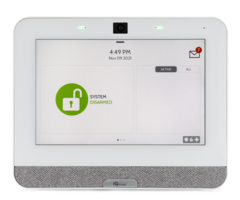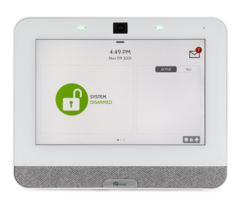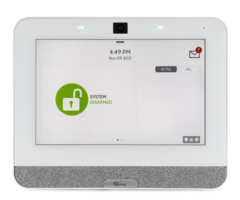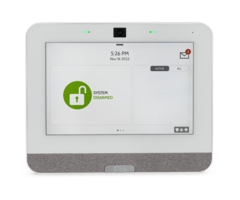Qolsys IQ Panel 4: Using with Honeywell 5800 Series
Related Products






Description
In this video, Dylan from Alarm Grid shows you how to use Honeywell 5800 Series sensors with a Qolsys IQ Panel 4. The most ...
Transcript
Hey, Diyers. Dylan here with Alarm Grid. Today, we're going to review how to get 5800 series sensors programmed to your IQ panel four. So to start, the first thing you're going to need is a system that are compatible with these sensors. That's going to be the three 45mhz version of the system that will work with these 5800 series sensors. The sensors themselves, they have, technically, three different brandings to them, all the same company. Just over time, the name has changed. So Ademco, Honeywell, and Resideo are all going to be three 45mhz sensors. And you can also add two gig sensors as well. That's going to work on the same frequency. So we're going to show you how to get this programmed to the system. And then do a quick test to show how it functions after. OK, so let's get one of these 5800 series sensors programmed to our IQ panel four. Today, we are going to be using the 5816 sensor, which is a Honeywell/Residio/Ademco sensor, which is going to be compatible with our three 45mhz version of the IQ panel four. So first things first, we're going to go to the top gray bar. That's going to bring our settings option. We'll go to settings. After settings, advanced settings. And we're going to use our default installer code, which is still set as 1111. Now with sensor installation, obviously, we're going to go into the installation option. We're going to go to devices and then security sensors. So as you see, we have a few options on how to get this program. We can either do auto-learn, which is fairly simple. And I'm going to show you how we're going to get it programmed that way. But real quick, we're going to look at the add sensor option. This is if you want to manually enter in the information for the sensor itself. If this is something you're going to do, the first thing you want to do is change the source for the sensor. Right now, you see it's set to the default power G option. And then you see right there, security RF 345. That's going to edit the screen a little bit. And then we can start programming manually. Sensor DLID is the serial number, which is located on a sticker on the side of the sensor. And there's also one inside the sensor as well on its board. It's about seven digits long. Type that in. And then you can adjust what type of sensor this is, door or window, how you want it to react, what loop it's going to operate on. You can add a sensor name. Chime type, so if the door is opened while the system is disarmed, this can make a little ding to let you know. Voice prompts is going to say what our sensor name is. So it will say, front window open. And then of course, we have the source which we've already changed. So we're not going to do the manual enrollment today. So I'll back out of there, back out of there, OK. So we're going to do the auto learn sensor feature. So press auto learn sensor. This is going to pull up the list of sensors we already have programmed. But we're going to take our magnetic contact 5816 sensor, we're going to simulate the window opening or door. Perfect. It pulls up a serial number of 0017214. We're going to check our sensor to make sure that matches. 0017214, OK. That brings us back to the edit page, where we can change the name, how the sensor reacts. So since we have this as a windows sensor, let's set it to 13 for the sensor group. Parameter D/W, this means that when this sensor is activated while the system is armed, there will be no delay countdown. It's just going to trigger the alarm right away. By default, it's set to loop two, which is how the 5816 operates when it's used as a wireless sensor. And everything else is looking good. So we'll do add new. Sensor added successfully. Perfect. Now, we just want to test that the sensor is going to work. So we'll go back to home. We're going to, again, simulate the window opening. Remove the magnet from the sensor. Front window open, perfect. Now, we're going to see if the window will close. Perfect. So we see we didn't get the announcement that the window closed. We didn't get a chime. But we do see that the visual indicator does go away. So just again, open and then close. OK, so that's how you get a 5800 series sensor program to your IQ panel four. As you saw, process is fairly simple. Testing is fairly simple. And these are fairly reliable sensors as well. So you shouldn't have any issues with these. If you did like the content, feel free to subscribe to our YouTube channel. Press the notification bell, so you can get notified for any more videos we release. If you have any questions for us or questions about the system or monitoring, you can call us at (888)-818-7728. We have a support email as well. The email address is support@alarmgrid.com. And we also have an online help chat. So if you come over to our website, www.alarmgrid.com, the chat will pop up. And feel free to ask any questions through there as well. My name is Dylan. I'm from Alarm Grid. And thank you for watching.
- Uploaded
